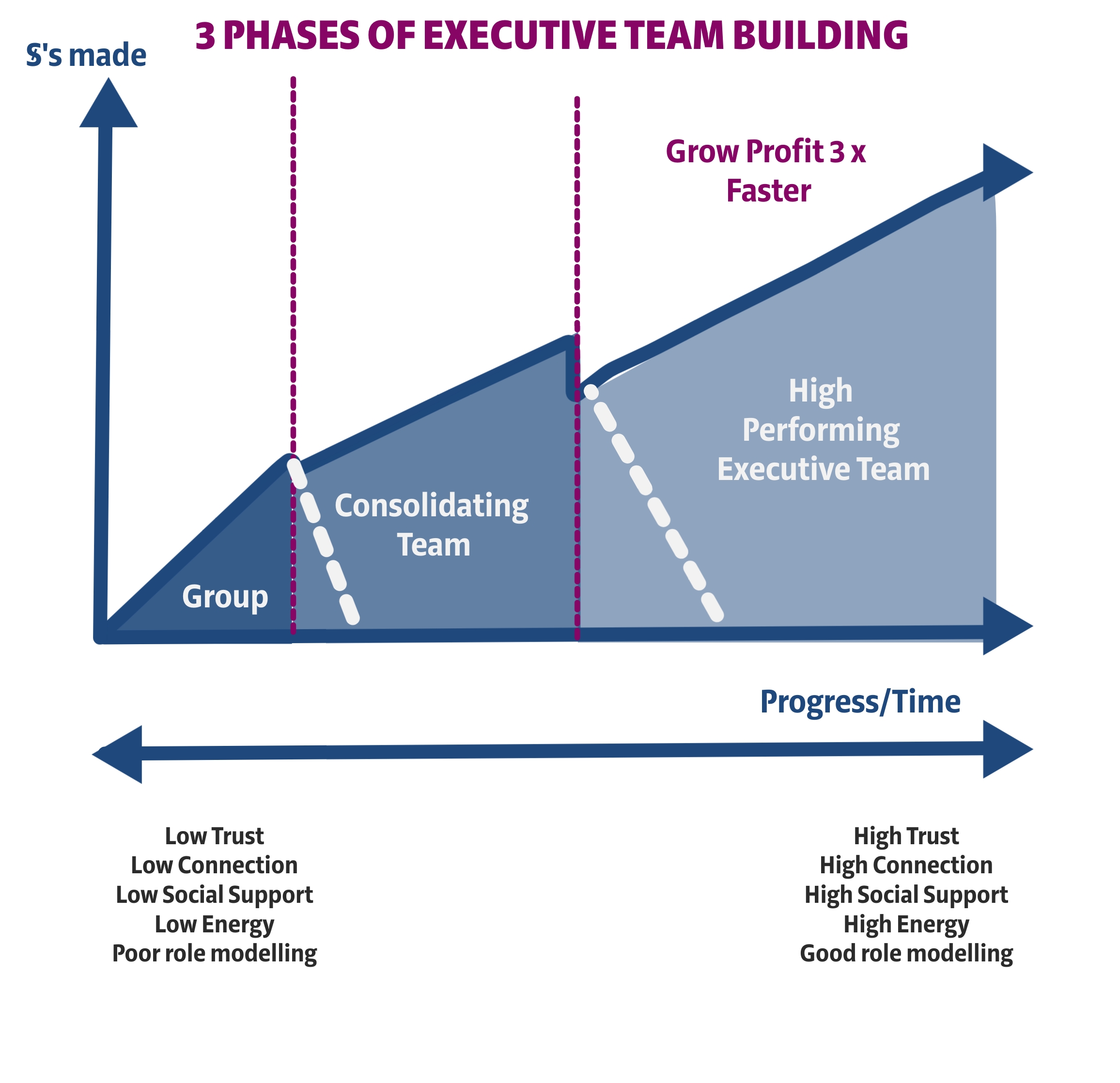
Today's complex, fast-changing world features speed, complexity and dense interdependencies. Problem solving in real time and focusing on continuous improvementis...
Everything is a product of evolution. Businesses go through cycles and need the right executives working at the right level for the business at that time. This comes down to the skills and experience of each executive, how frequently they interact with one other and whether the organisation is in crisis, transformation or growth mode.
You can think of these different stages as like an elevator that passes through floors, or in this case inflection points. When companies grow, they come to a certain place where things that used to work, don’t work anymore. Breaking through these inflection points are critical to revenue and company success. Each inflection point requires the organisation to reinvent itself. This includes executives up-levelling and improving both their intrapersonal and interpersonal skills.
Essentially, leadership teams (and the organisation) are either moving forwards or sliding backwards. If leadership behaviours, don’t adapt, things aren’t getting better, they’re getting worse. The chart below represents how much your team trusts one another which impacts how effectively you can execute on ambitious goals.

There are two currencies that profoundly indicate the success of leadership. The first is how much money the team makes on achieving ambitious goals or delivering projects to the standard expected by customers. The second currency is the time it takes to complete projects. Obviously, the more goals that are completed, the more money an organisation makes cumulatively as time progresses.
There are three different types of executive teamwork.
Sometimes leadership teams act more like a group than a team. Team members tend to work independently focusing on their respective areas. This is acceptable if you have specialised projects that require minimal collaboration. But at some point, most organisations need to improve teamwork within the organisation, in order to grow.
At this level, it’s very difficult to make progress on group goals because people have little experience or incentive for improving cooperation. Individual priorities, accountabilities, and deliverables are the rule. So you get clumsy co-ordination, missed deadlines, slow decision-making and poor communication among team members.
Underpinning these behaviours are beliefs by individuals that they can’t trust other team members. As a result, self-interest rules including a lack of consideration for others, agenda pushing and assumption of negative intent.
Typically, breaking through this inflection point is a result of having to work on projects together due to market demand or because the CEO is requesting a one firm focus. Unfortunately, some organisations don’t make it through this point. If leadership team interactions don’t improve, the company can easily fail to break through the inflection point.
At this stage, you have the group learning how to work together as a team and with other teams. Coordination is improving but you’ll find there is a lot of rework, duplication, working around others and miscommunication. Bottlenecks between functions tend to occur slowing down efficiencies and increasing frustrations.
The team is learning how to share information, listen to others and co-ordinate and prioritise work. Get it wrong and the business is at risk of falling behind.
Most teams operate at this consolidation phase reaching a plateau - never kicking into high performance. When I collate my SUCCEeD Together Senior Leadership Team Assessment® results, average leadership team performance is around the 63% trust level.
When teams work through my senior leadership program, they can break through this phase and leap into the next zone of 80%+ trust or more.
To take an organisation to this level requires completely changing leadership mindsets, behaviours, relationships and communication. It means excelling at working interdependently, making fast decisions, prioritising and co-ordinating work and being responsive.
Teams that trust each other swiftly execute on their goals with minimal collateral damage. They work together in teamlike oneness – reading each other’s moves and intent. Like footy players expertly hand-balling the football from one side of the field to the other - reaching the goal post effortlessly. This is when people are collaborative, there’s high social support, fast decisions, truth-seeking conversations and people are pushing each other to achieve. It is where you get high energy and connection and people working cross-functionally.
In this zone, the team is kicking through goals faster than ever before building powerful momentum. As Patti McCord, the former Netflix Human Resources Executive, says in the book Powerful, it's when you “get twice the work done with a third of the people and more fun.” Research by the CEB Corporate Leadership Council bears this out, uncovering that engaged teams grow profits three times faster than less engaged ones.
But this rarely occurs organically. After all, teams are constantly changing - new members, new strategies or new circumstances can see high performing teams deteriorate to only collaborating like a group. It takes dedicated effort and planning, led by the CEO, to help the executive team move from acting as a group, or a consolidating team to one that is high performing. While this does require CEOS to dedicate extra time to improve their leadership team, the results are worth it. Customised and focused executive team building is required to help you reach this zone faster.
If you want to learn more about the five steps to improve your senior leadership team results, download my free Building a Cohesive Leadership Team insights paper. If you want to learn more about how I can help improve your results, contact me here.

Today's complex, fast-changing world features speed, complexity and dense interdependencies. Problem solving in real time and focusing on continuous improvementis...

When it comes to helping companies build trust internally, one of the things I learnt pretty quickly is that if 1-2 members of the executive team do not support any...